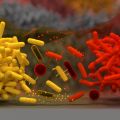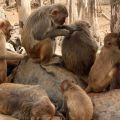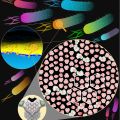
New study shows tiny animals steal antibiotic recipes from bacteria
A group of small freshwater animals protect themselves from infections using antibiotic recipes stolen from bacteria, according to new research led by the University of Oxford that could help develop future medicines.
These strange little animals have spent millions of years copying the DNA that tells microbes how to make antibiotics...We watched them using one of these genes against a disease caused by a fungus, and the animals that survived the infection were producing ten times more of the chemical recipe than the ones that died, indicating that it helps to suppress the disease.
Lead study author Dr Chris Wilson, Department of Biology, University of Oxford.
The little-known creatures called bdelloid rotifers (which means ‘crawling wheel-animals’) live in moss, ponds, and soil. Like other animals, they have a head, mouth, gut, muscles, and nerves - yet they are smaller than a hair’s breadth.
When these rotifers catch an infection, the study found, they switch on hundreds of genes that have been copied into their DNA from bacteria and other microbes. Some of these genes produce antibiotics and other protective chemicals against the disease.
‘When we translated the DNA code to see what the stolen genes were doing, we had a surprise’, said lead study author Dr Chris Wilson from the Department of Biology, University of Oxford. ‘The main genes were instructions for chemicals we didn’t think animals could make — they looked like recipes for antibiotics.’
Earlier research found that rotifers have been picking up DNA from their surroundings for millions of years, but the new study was the first to discover them actively using these genes against diseases. No other animals are known to “steal” genes on such a large scale.
Antibiotics, like penicillin, are essential to modern healthcare, but most of them were not invented by scientists. Instead, they are produced naturally by fungi and bacteria in the wild, and humans can make artificial versions to use as medicine.
The new study, published today in the journal Nature Communications, suggests that rotifers might be doing something similar.
‘These strange little animals have spent millions of years copying the DNA that tells microbes how to make antibiotics,’ explains Dr Wilson. ‘We watched them using one of these genes against a disease caused by a fungus, and the animals that survived the infection were producing ten times more of the chemical recipe than the ones that died, indicating that it helps to suppress the disease.’

The scientists think that rotifers could give important clues in the hunt for future drugs to treat infections caused by bacteria or fungi in humans and other animals.
Antibiotics are becoming less effective because the disease-causing microbes have evolved to become resistant and no longer respond to treatment. The World Health Organization recently sounded the alarm, warning in a June report of the ‘pressing need’ to develop new antibiotics to counter the threat of resistance.
‘The recipes the rotifers are using look different from known genes in microbes,’ said study co-author Dr Reuben Nowell, from the University of Stirling. ‘They are just as long and complicated, but parts of the DNA code have changed. We think the recipe has been altered by a process of evolution to make new and different chemicals in the rotifers. That’s exciting because it might suggest ideas for future medicines.’
One problem with developing new drugs is that many antibiotic chemicals made by bacteria and fungi are poisonous or have side-effects in animals. Only a few can be turned into treatments that safely clear harmful microbes from the human body.
If rotifers are already making similar chemicals in their own cells, the researchers think they could lead the way to drugs that are safer to use in other animals, including people.

A big question for the scientists is why rotifers are the only known animals that borrow these useful genes from microbes at such high rates.
‘We think it might be linked with another strange fact about these rotifers,’ said Professor Tim Barraclough, a study co-author from the University of Oxford. ‘Unlike other animals, we never see any males. Rotifer mothers lay eggs that hatch into genetic copies of themselves, without needing sex or fertilisation.’
According to one theory, animals that copy themselves like this can become so similar that it can make the population vulnerable. ‘If one catches a disease, so will the rest,’ explained Professor Barraclough. ‘If they don’t find a way to change their genes, they could go extinct. This might help explain why these rotifers have borrowed so many genes from other places, especially anything that helps them cope with infections.’
Dr Nowell thinks there is much more to learn from rotifers and their stolen DNA. ‘We found that rotifers are using hundreds of genes that aren’t seen in other animals. The antibiotic recipes are exciting, and some other genes even look like they have been taken from plants. The findings are part of a growing story about how and why genes get moved between different kinds of life,’ he said.
The study ‘Bdelloid rotifers deploy horizontally acquired biosynthetic genes against a fungal pathogen’ has been published in Nature Communications.
 New analysis of archaeological data reveals how agriculture and governance have shaped wealth inequality
New analysis of archaeological data reveals how agriculture and governance have shaped wealth inequality
 Cambridge victorious in Women's and Men's Boat Races 2025
Cambridge victorious in Women's and Men's Boat Races 2025
 Expert Comment: Ethical and legal challenges of uterus transplants in Mexico
Expert Comment: Ethical and legal challenges of uterus transplants in Mexico
 Armed to the hilt: Study solves mystery behind bacteria’s extensive weaponry
Armed to the hilt: Study solves mystery behind bacteria’s extensive weaponry
 Friendly monkeys have friendly microbes
Friendly monkeys have friendly microbes
 Bacterial armour plating has implications for antibiotics
Bacterial armour plating has implications for antibiotics